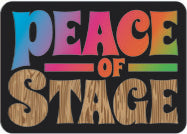About the Stage
The stage was only 8,000 square feet. Not overly large by outdoor concert or festival standards. It took several weeks for local craftsmen to construct. But on those 8,000 square feet proudly stood rock royalty and now it serves as a glorious, lasting symbol of an entire generation.
From the stage, one could see 500,000 people crammed up the hill, off to the sides and even on the other side of the road. On that stage, you could feel the rain pelting you from the sky, literally bathing the entire crowd in a unity that would never end. From that stage, you felt the excitement of the music, mixed with fear that the towering speaker stands could give way at any time.
Those who stood on that magical stage shared a moment of oneness with the hundreds of thousands who came to be with them. It was the stage that brought out the opening guitar chords of Richie Havens. It was the stage that bore the incredible Who set, complete with several Daltrey mic throws, a multitude of Townshend windmills and jumps, the wild Keith, and the stoic Ox. It was the stage that gathered Ten Years After, Sly, the Airplane, the Dead, Creedence, and a soggy Santana, who brought the crowd to a frenzy with “Soul Sacrifice.” Janis stood on
that stage. It breathed life into folkies like Joan Baez, Tim Hardin, Bert Sommer, and Melanie.
On that stage, John Sebastian sheepishly walked out and played an unexpected set that gave everyone pause and even some needed reflection. Country Joe gave the Yang to Sebastian’s Ying with the “Fish Cheer.” CSNY had their second gig on that stage while Joe Cocker and the Band both lit up an exhausted Sunday crowd. It supported a dancing Sha Na Na so early in the morning and it breathed its last with Jimi Hendrix’s iconic set, which included “The Star Spangled Banner.”
A host of people likely saved some lives with key announcements from that stage about what to ingest and not, where the food was, who was missing, where to go for medical help and so on. Arlo Guthrie told the crowd how many people were there and literally offered up a traffic report. Wavy Gravy stepped out and gave nearly half a million people the menu for breakfast.
And from the center of that stage, Max Yasgur, a simple man with little desire to be in the public eye, became one of the few bridges between generations as he boldly told the world that despite opposition from his neighbors and friends, he stood for the festival and praised the people attending it.
So many of the artists, stagehands, landowners, activists, and others, who were center stage or in the wings are gone now. But the music from August 1969 always lives on. The memories of the concert live in each of us and the stage - that incredible stage which was built by hand and lasted through downpours and thunderous performances - lives on.
The events at Woodstock have become larger than life, having reached almost mythical status, both among those were there and those who wished they were. The people who attended represented an entire generation that took Woodstock as its own and made it a symbol of who they were and what they believed in! To be part of Woodstock meant something to hold onto forever: presence at an iconic moment that can never be recreated. That magic extended to those who saw the film, bought the album, went to the museum, or made pilgrimages to the site. And, now the magic can inspire your surroundings with the purchase from the Peace of Stage Collection with designs featuring a reverently deconstructed piece of the original Woodstock Stage.
But what more can you do with the stage that is so unique and held in veneration by all who were touched by any part of the Woodstock experience? That stage will be used to help several important charities that serve people who were there or couldn’t be to do their vital work in the name of the Woodstock Generation. A portion of the net proceeds from the sale of small glass bottles containing stage sawdust, called Stardust, will be donated to worthy organizations that carry on the work of helping others and caring for our world. We can think of no more honorable thing to do with the centerpiece of the festival - the original Woodstock Stage - that represented our music, our “thing,” than to use it to help others.
Be sure to follow us on Facebook, Twitter, and Instagram to stay up to date on where the stage is headed next!
MAIN STAGE FACTS
- Built in 23 days, under the supervision of legendary lighting designer and Woodstock Master of Ceremonies Chip Monck.
- Measured 80 feet by 100 feet
- Built by hundreds of construction workers from Sullivan County and the surrounding area.
- Fans arrived several days before the stage was completed
- Dismantling the stage took three weeks

